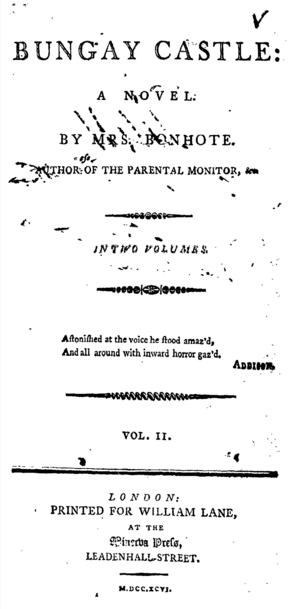Elizabeth Bonhôte facts for kids
Quick facts for kids
Elizabeth Bonhôte
|
|
|---|---|

Title page of volume 2 of Bungay Castle (1797) by Elizabeth Bonhôte
|
|
| Born | Elizabeth Mapes baptised 11 April 1744 Bungay, Suffolk, England |
| Died | 11 June 1818 (aged 74) Bungay, Suffolk, England |
| Occupation | writer |
| Notable works | Bungay Castle |
| Spouse | Daniel Bonhôte (m. 1772) |
Elizabeth Bonhôte, born Elizabeth Mapes, was an English writer. She wrote novels, essays, and poems. She was born in 1744 and passed away in 1818. Her most famous book was Bungay Castle. This was a Gothic romance story. She wrote it after her husband bought the old ruins of the real Bungay Castle.
About Elizabeth's Life
Elizabeth Mapes was born in April 1744 in a town called Bungay in Suffolk, England. Her father, James Mapes, was a baker and grocer. Her mother's name was Elizabeth.
In 1772, Elizabeth married Daniel Bonhôte. He was a lawyer and landowner in Bungay. They had three children together. One of their daughters, also named Elizabeth, married a reverend named Richard Dreyer. Daniel Bonhôte later became a sheriff's assistant for Suffolk. He was also a captain in a local army group. He died in 1804.
Elizabeth Bonhôte passed away in Bungay in 1818. She left behind several houses and a bakery. She also left a good amount of money. She used some of her money to start special homes called almshouses. These homes were for older women and widows of poor traders. Today, a street in Bungay is named Elizabeth Bonhote Close, honoring her.
Elizabeth's Writings
Elizabeth Mapes started writing before she was married. She wrote poems that praised the king and queen. Her first novel, Hortensia, or, The Distressed Wife, came out in 1769. She wrote it without using her name. People said she was very happy with England's laws and government.
In 1772, the same year she got married, her second novel was published. It was called The Rambles of Mr Frankly, Published by his Sister. This book taught moral lessons. It was thought to be like A Sentimental Journey by Laurence Sterne. In the book, Mr. Frankly learns by watching people during his walks in Hyde Park. This book became very popular and was even translated into German.
After having her children, Elizabeth was ill for a while. This caused a break in her writing. She started again with the novel Olivia, or, The Deserted Bride in 1787.
Her next work was a guide for her children. It was called the Parental Monitor. This book had moral essays to help guide her children. It came out in two parts in 1788. One part was for girls and one for boys. A modern expert said it taught children to accept their situation and rely on adults. Two more novels, Darnley Vale, or, Emelia Fitzroy (1789) and Ellen Woodley (1790), were reviewed in a famous magazine called the Monthly Review. Her Parental Monitor was printed again in 1796 in both London and Dublin.
Elizabeth Bonhôte's most successful novel was inspired by a real place. In 1791, her husband bought the old ruins of Bungay Castle. The grand look of the castle gave her the idea for Bungay Castle. This was a Gothic romance story. It was published in 1796 by a popular company called Minerva Press. She dedicated the book to the Duke of Norfolk. This book was so popular that it was printed again as recently as 2006.
Elizabeth Bonhôte also wrote poems throughout her life. Her last published work was a poem called Feeling, or, Sketches from Life: a Desultory Poem in 1810.

